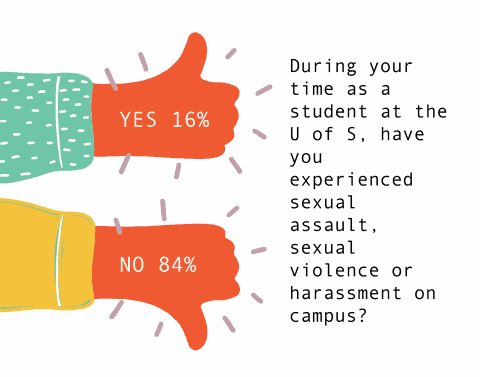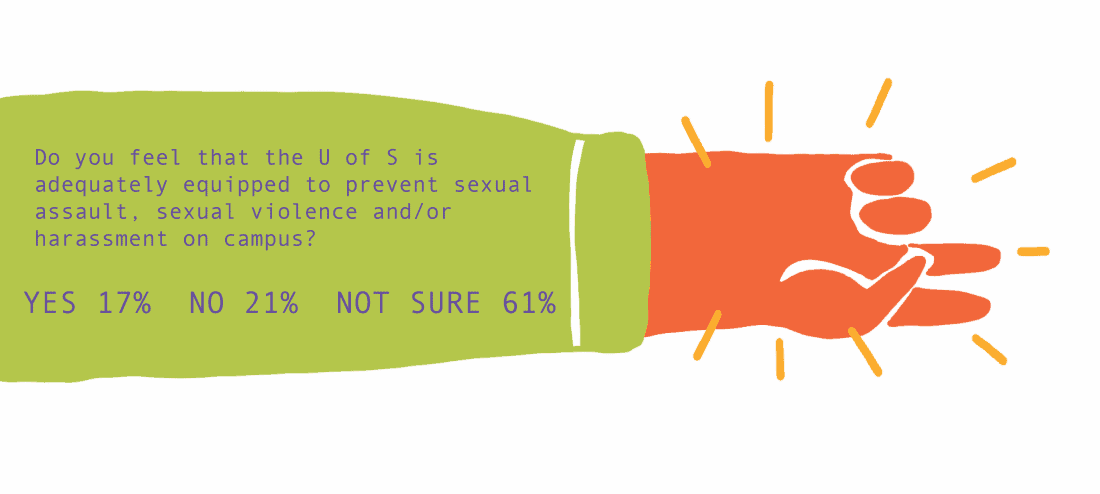
Sexual violence still occurs wherever we live, work, study and move throughout the day — so it is imperative for students to understand and continually challenge the supports and preventative measures that our post-secondary institutions provide.
Any sexual act or any act targeting an individual’s sexuality, gender identity or gender expression — whether physical or psychological in nature — which is committed, threatened or attempted against an individual without that individual’s affirmative consent is considered an act of sexual violence.
The term “sexual violence” is not limited to sexual assault, but also includes sexual harassment, stalking and voyeurism — in other words, non-consensual viewing or recording, done for a sexual purpose, of an individual or individuals in a situation where privacy is expected — among other circumstances. The distribution of sexually explicit photographs or recordings without the consent of the receiver is an example of sexual violence.

Affirmative consent is a voluntary agreement to engage in sexual activity. It requires clear communication, and each individual must be able to freely — without intimidation — choose between yes and no. Consent is never obligated or implied and must be maintained up to and during sexual activity.
Sexual violence can impact people in many ways — including physical injuries, pregnancy, sexually transmitted infections, mental-health challenges, self-injurious coping behaviours and personal and professional tensions. Experiencing sexual violence can change how you view trust, your own self-worth and relationships. The effects of sexual violence often remain with survivors years after an experience.
The Sexual Assault Prevention Policy — introduced to the U of S in December, 2015 — provides a fairly comprehensive detailing of the procedures and processes by which the university handles disclosures, reports and complaints with regards to instances of sexual violence on campus.
One poignant quotation from the policy reads, “All members of the University of Saskatchewan community have a right to work, live, and study in an environment that is free from any form of sexual assault and other forms of sexual misconduct.”
The U of S is among a host of post-secondary institutions across the country that have implemented a stand-alone sexual-violence policy such as this, with legislation in the provinces of Ontario, British Columbia and Manitoba deeming these policies a mandatory requirement for universities in these areas since 2017.
Such policies in post-secondary institutions serve to acknowledge sexual violence as an issue that has a significant effect on a student’s well-being and academic success. These policies should offer adequate and accessible support for survivors, as well as clear and comprehensive procedures for disclosures, reports and official complaints against perpetrators of sexual violence.

The Sexual Assault Prevention Policy at the U of S is a long-term commitment for vice-provost, teaching and learning, Patti McDougall.
“I think that all of the work that we’ve done over the last few years has really been focused on what we can do through our policy, procedures and campaigns to encourage people to come forward,” McDougall said.
With a survivor-centric approach, the Sexual Assault Prevention Policy puts emphasis on the value of disclosure or getting help. Partnered with the U of S Students’ Union, and with support from the Saskatoon Sexual Assault & Information Centre, the U of S offers many different avenues through which to receive support with this policy.
“Unless people come forward and speak out, we’re never going to be able to make this stop — we’re never going to be able to end the sexual violence… [Coming forward] makes it more possible to help the individual and for there to be positive change in that regard,” McDougall said. “Fundamentally, it’s about the care of the individual.”
One of the best attributes of the U of S Sexual Assault Prevention Policy is that it’s collaborative. In December 2017, McDougall met with student leaders from the USSU, the Graduate Students’ Association, and the Pride and Women’s centres to evaluate the policy based on the standards set by the national student-advocacy group OurTurn.
“Whenever we work in this area — as was the case when we developed the policy — we seek feedback from the community to know whether we’re on the right track,” McDougall said.
In the future, McDougall plans to continue these conversations, as well as invite more people who might be interested into the discussion.
Another point of note is the university’s commitment to education efforts aimed at preventing sexual assault and misconduct on campus, as well as mandated training for individuals in the campus community who may be called on to assist and guide someone in a disclosure involving sexual violence. This training is designed to help peer mentors, staff and faculty establish safe and comfortable spaces as well as maintain confidentiality.
In many ways, the U of S is certainly succeeding in its efforts. McDougall notes that an increase in disclosures and reports means more people trust that they will be believed, respected and supported — and that their questions will be answered when they come forward.
“After someone has disclosed a sexual assault and we’ve mobilized and responded, we always ask that person if they’d be willing to talk with me, at a comfortable point, and everyone has said yes in the last couple of years,” McDougall said. “Fortunately, the feedback has been generally positive, and it gives me confidence in those people who are on the front lines responding.”
There is still room for improvement, however. The Sexual Assault Prevention Policy currently lacks set timelines by which processes should occur in response to a disclosure, report or formal complaint. This could leave survivors in uncomfortable or even unsafe positions while waiting on a verdict.

Furthermore, the policy does not stipulate immunity clauses for drug use and underage drinking — an oversight considering that fear of punishment will prevent some individuals from coming forward and seeking help.
In the future, the university might also consider implementing academic accommodations for survivors of sexual assault and misconduct in all course syllabi.
In a society that continues to facilitate rape culture, we must consistently make strides to be heard, to live, to work, to study and to pursue success without fear, guilt or shame caused by sexual violence. Through better understanding, we can challenge the status quo.
Disclose and get help: Choose to tell someone about what has happened — this can be a friend or family member you trust or a university staff member or peer mentor. University staff and peer mentors are committed to providing support in a non-judgemental and empathetic manner. They can help with decision-making and will refer you to appropriate resources, whether on or off campus.

Make a report for the official record: You can report an incident to Protective Services on campus, as well as the Saskatoon Police Service.
If you have witnessed sexual assault or sexual misconduct, or if you have become aware of an incident of sexual assault or sexual misconduct, it is also possible to make a report, but it is important to note that, if someone chooses to disclose to you, you should seek their permission before going on the record.
Following a report, Protective Services — or in some cases, an alternate body appointed by the university — will investigate the incident. The university may also impose non-punitive interim measures, such as separation of academic and living situations or temporary suspension or modification of the accused person’s academic program.
Seek justice by filing a formal complaint: You — or any other individual, including a university official speaking on your behalf — can file formal complaints through both Protective Services and the Saskatoon Police Service.
At the university level, complaints against students are handled through the Standard of Student Conduct in Non-Academic Matters and Regulations and Procedures for Resolution of Complaints and Appeals — or in other words, as non-academic misconducts.
Complaints against university employees are handled under the Discrimination and Harassment Prevention Policy, Violence Prevention Policy or the applicable collective-bargaining agreement.
Remember that you have the right to withdraw a complaint at any time and that you are protected against any form of retaliation by the accused person.
If the accused person is not a student or employee, the university can still assist you in filing a report with the Saskatoon Police Service and can take steps to legally prohibit an individual from coming onto a U of S campus.

Who can you call on?
A friend or family member you trust
Women’s Centre
Room 103, Memorial Union Building
womens.centre@ussu.ca
Pride Centre
Room 104, Memorial Union Building
pride.centre@ussu.ca
Aboriginal Students’ Centre
Gordon Oakes Red Bear
Student Centre
306-966-5790
asc@usask.ca
Help Centre
Room 105, Memorial Union Building
help.centre@ussu.ca
Student Wellness Centre
Third and fourth floors, Place Riel
Student Centre
306-966-5768
Saskatoon Sexual Assault & Information Centre
24-Hour Crisis Line: 306-244-2224
Office Line: 306-244-2294
—
Emily Migchels / Opinions Editor
Graphics: Lesia Karalash / Graphics Editor
All statistics collected from U of S students who participated in an online poll conducted by the Sheaf.